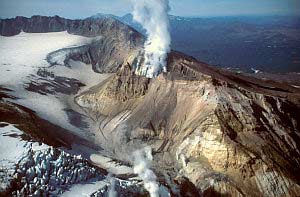New findings may help predict volcanic activity
At the Scientific Conference of the British Association for Scientific Development (BA) in the UK, a group of scientists from the country said they had discovered a mechanism that took place in the heart of the volcano that caused it to erupt.
Scientists hope this finding, combined with other observations, could help predict volcanic activity.
 Mutnovsky volcano belongs to the Kamchatka peninsula (Photo: travelkamchatka) In the process of studying the activity of a volcano in the mountains of St. Helens (USA) and a volcano on the Siberian Kamchatka peninsula (Russia) with the help of new techniques, scientists realized when lava from deep inside the volcano rose to the mouth before the volcano erupted. It has turned into crystal particles to counteract the pressure drop and become hotter.
Mutnovsky volcano belongs to the Kamchatka peninsula (Photo: travelkamchatka) In the process of studying the activity of a volcano in the mountains of St. Helens (USA) and a volcano on the Siberian Kamchatka peninsula (Russia) with the help of new techniques, scientists realized when lava from deep inside the volcano rose to the mouth before the volcano erupted. It has turned into crystal particles to counteract the pressure drop and become hotter.
The closer to the crater, the lava becomes even hotter (up to 100 degrees Celsius), creating a very strong pressure, like the pressure of a trigger, causing the volcano to erupt.
To determine the temperature of the lava, the scientists analyzed the amount of water, metal and chemical components in the lava droplets as it escaped the crater. Through analysis, scientists not only accurately measured the temperature and crystal ratio in lava but also the depth of the volcano.
Until now, scientists only observed the activity of volcanoes on their surfaces. The new discovery by British scientists demonstrates that it is possible to track what happens in the volcano before it erupts.
- Volcanic activity makes the Earth cooler
- Find the key to predict the volcanic eruption
- Effect of volcanic eruption phenomenon
- Earth is threatened by new ice age?
- Brain activity indicates favorite music
- Shiveluch volcano sprayed 9000 meters of dust
- It is possible to predict premature women
- The beautiful volcanic landscape shot by the drone
- Volcanic activity on the Moon more than 4 billion years ago
- Video: Japan's largest volcano
- Find alien organic material at the top of Mount South Africa
- The world is about to have a new volcanic disaster
 Is the magnetic North Pole shift dangerous to humanity?
Is the magnetic North Pole shift dangerous to humanity? Washington legalizes the recycling of human bodies into fertilizer
Washington legalizes the recycling of human bodies into fertilizer Lightning stone - the mysterious guest
Lightning stone - the mysterious guest Stunned by the mysterious sunset, strange appearance
Stunned by the mysterious sunset, strange appearance